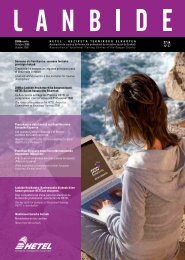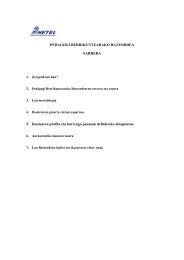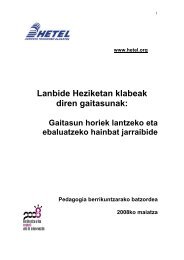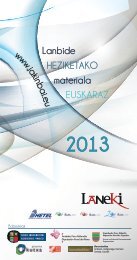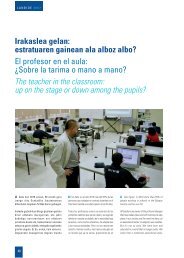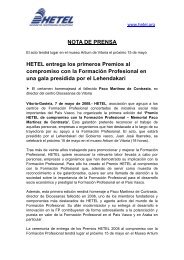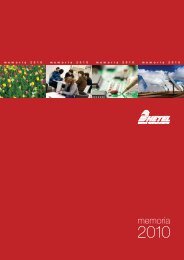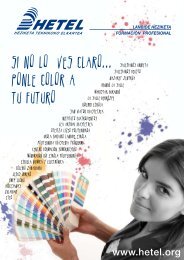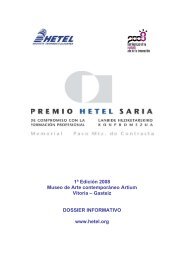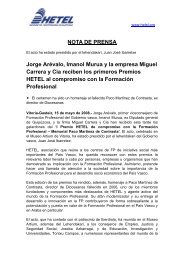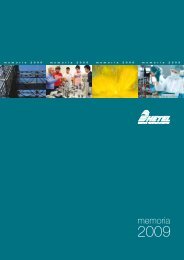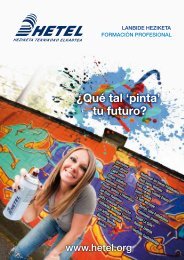31 zk Nº 31 - Hetel
31 zk Nº 31 - Hetel
31 zk Nº 31 - Hetel
You also want an ePaper? Increase the reach of your titles
YUMPU automatically turns print PDFs into web optimized ePapers that Google loves.
HETELkaria 2012<br />
Amaitu dira DESIGNet - Sareko Industria<br />
Diseinua eta Mechanical Design<br />
Manufacturing berrikuntza proiektuak<br />
Finalizan los proyectos de innovación<br />
DESIGNet - Diseño industrial en red y<br />
Mechanical Design Manufacturing<br />
DESIGNet Industrial Design and Mechanical<br />
Design Manufacturing innovation projects<br />
conclude<br />
ta zikloko ikasleek mekanizatzen edo gauzatzen<br />
dituzte. Talde lana funtse<strong>zk</strong>o ezaugarria<br />
da lan munduko profesionalen artean; izan<br />
ere, delineatzaileek diseinatzen dutena lantegietan<br />
gauzatzen dute gero mekanikariek.<br />
Proiektuen funtsa, beraz, egoera hori bera<br />
ikasgelara eramatea da.<br />
Mundua gero eta globalizatuago da eta, testuinguru<br />
horretan, proiektuak leku batean<br />
garatu eta beste batean gauzatzen dira. Ildo<br />
horretan, HETELeko ikastetxeak ere hainbat<br />
eskualdetan kokatuta egotea antzeko agertokia<br />
da, horrelako sareko lan proiektuak burutzeko<br />
egokia.<br />
DESIGNet - Sareko Industria Diseinuko<br />
proiektuan diharduten Fabrikazio Mekanikoaren<br />
Diseinuko Heziketa zikloko ikasleak<br />
kastetxe ezberdinetako ikaslez osatutako<br />
taldeetan antolatu dira. Lankidetzako metodologietan<br />
(Problem Based Learning – PBL),<br />
eta informatika tresnetan trebatzeko prestakuntza<br />
saioaren ostean, konpondu beharreko<br />
kasu bat proposatu zitzaien. Aukeratutako<br />
konponbidearekin, proiektu tekniko bat landu<br />
zuten, hurrengo ikasturteko Produkzioaren<br />
Plangintzako ikasleek mekanizatzeko baliagarri<br />
izan dezaketena. Mechanical Design<br />
Manufacturing proiektuan diharduten Produkzioaren<br />
Plangintzako ikasleek aurretik<br />
proposatutako diseinu bat mekanizatu dute,<br />
fabrikazioaren eta akaberaren aldetik ahalik<br />
eta konponbiderik onena ematen saiatuz.<br />
Kasu horretan ere, ikastetxe ezberdinetako<br />
ikaslez osatutako lantaldeak aritu dira<br />
proiektuan.<br />
Bi proiektuok sortutako<br />
jakin-min eta pizgarriei<br />
esker, horien inguruan<br />
bestelako he<strong>zk</strong>untza<br />
dinamika sortu da,<br />
atsegina, praktikoa eta lan<br />
mundutik eta industriaren<br />
errealitatetik hurbil<br />
Bi proiektuok aurrera eramateko, ikasleek<br />
hainbat komunikazio tresna erabili dituzte<br />
eta bideokonferentzia ere bilerak egiteko<br />
funtse<strong>zk</strong>o tresna izan dute sarritan. Bi bilera<br />
mota egin dituzte: aurkezpenak egiteko<br />
bilera orokorrak (Webex erabiliz) eta talde<br />
bakoitzak egindako bilerak (Skype erabiliz).<br />
Horrez gain, gaur egungo smartphone-ek<br />
eskainitako komunikazio aukerak ere erabili<br />
dituzte. Informazioa gorde eta taldeen arlidad:<br />
la incorporación de la innovación en el<br />
plano metodológico (trabajo colaborativo), y<br />
las posibilidades de comunicación que ponen<br />
a nuestra disposición las herramientas<br />
TIC. Además ambos proyectos suponen un<br />
acercamiento de la realidad industrial al<br />
aula y se han desarrollado con la financiación<br />
para proyectos de innovación aplicada y<br />
transferencia del conocimiento en la Formación<br />
Profesional del Ministerio de Educación.<br />
Los proyectos DESIGNet – Diseño industrial<br />
en red y Mechanical Design Manufacturing<br />
se desarrollan en el seno de la familia de<br />
Fabricación Mecánica. El alumnado del Ciclo<br />
formativo de grado superior de Diseño en Fabricación<br />
mecánica se prepara para diseñar<br />
y/o desarrollar proyectos industriales que<br />
posteriormente serán mecanizados o materializados<br />
por alumnado del Ciclo formativo<br />
de grado superior de Planificación de la<br />
producción. El trabajo en equipo constituye<br />
la característica fundamental de los profesionales<br />
en el mundo laboral y de hecho, los<br />
mecánicos ejecutan en taller lo que diseñan<br />
los delineantes. La idea consiste en reproducir<br />
esa misma situación en el aula.<br />
En un contexto mundial cada vez más globalizado<br />
donde los proyectos se desarrollan y<br />
ejecutan en diferentes lugares, la situación<br />
en diversas comarcas de los centros HETEL<br />
pueden constituir un escenario similar, idóneo<br />
para llevar a cabo un proyecto de trabajo<br />
en red como este.<br />
Los alumnos del proyecto DESIGNet – Diseño<br />
industrial en red, del Ciclo Diseño en<br />
Fabricación Mecánica, se han organizado<br />
en equipos compuestos por alumnos de<br />
distintos centros. Tras una formación en<br />
metodologías colaborativas (Problem Based<br />
Learning - PBL) y en herramientas informáticas,<br />
se les planteó un caso que tenían que<br />
resolver. Con la solución elegida elaboraron<br />
un proyecto técnico que puede servir en el<br />
curso siguiente a alumnos de Programación<br />
de la producción para mecanizar. Los alumnos<br />
del proyecto Mechanical Design Manufacturing,<br />
del Ciclo superior Planificación<br />
de la Producción han mecanizado un diseño<br />
que se les ha propuesto con anterioridad,<br />
tratando de darle la mejor solución de fabricación<br />
y acabado. También en este caso<br />
han sido grupos de trabajo con alumnos de<br />
diferentes centros.<br />
Para llevar a cabo los dos proyectos el alumnado<br />
ha recurrido a diversas herramientas<br />
de comunicación y ha hecho uso frecuente<br />
de la videoconferencia como elemento clave<br />
para llevar a cabo reuniones. Se han realiza-<br />
The DESIGNet Industrial Design and Mechanical<br />
Design Manufacturing projects were implemented<br />
within the Mechanical Manufacturing<br />
domain. Students in the Manufacturing Design<br />
High Degree Vocational Training Course learn<br />
to design and/or develop industrial projects<br />
that will later be machined or materialised by<br />
students of the Production Planning High Degree<br />
Vocational Training Course. Teamwork is<br />
the hallmark of professionals in the workplace<br />
where workshop personnel make the parts<br />
that have been designed by their colleagues.<br />
The idea is to reproduce the same situation in<br />
the classroom.<br />
In a context of an increasingly globalised<br />
world where projects are developed and implemented<br />
in different places, the situation<br />
in the various districts where there are HETEL<br />
schools may be similar, suitable for conducting<br />
a networking project like this.<br />
Students in the DESIGNet Industrial Design<br />
project are studying in the Manufacturing Design<br />
High Degree Vocational Training Course<br />
and they have organised themselves in teams<br />
from different schools. After training in collaborative<br />
methodologies (Problem Based<br />
Learning - PBL) and computer tools, they were<br />
given a case they had to solve. With the chosen<br />
solution they produced a technical project<br />
that could serve in the next academic year for<br />
Machining Production Planning. Students in<br />
the Mechanical Design Manufacturing project<br />
are studying in the Production Planning High<br />
Degree Vocational Training Course. They machine<br />
a project that was presented to them<br />
previously, trying to find the best manufacturing<br />
and finishing solution. Also in this case the<br />
working teams consist of students from different<br />
schools.<br />
To implement the two projects the students<br />
resorted to various information and communication<br />
tools and made frequent use of videoconferencing<br />
as a key element in conducting<br />
meetings. There were two types of meetings,<br />
global presentation meetings (using Webex)<br />
and meetings within each team (using Skype).<br />
Current communication opportunities offered<br />
by smartphones were also used. To store and<br />
share information among teams, the use of<br />
tools like Dropbox and Google Docs was encouraged.<br />
For interactive communication between<br />
students and teachers the open source<br />
Moodle platform was used.<br />
In late May, a technical webinar was held on<br />
Industrial design. The webinar brought together<br />
students of both projects and a significant<br />
number of guests without the need for travel.<br />
Transmission was carried out from the facili-<br />
20



